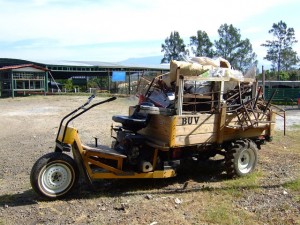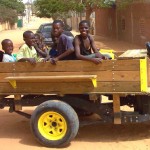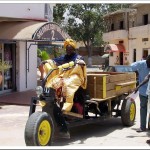BUV Design – Wooden Bed vs. Steel Bed
One of the main concerns we had in desiging and building the BUVs is maintenance. We have mentioned before that the Basic Utility Vehicle (BUV) is extremely durable with brakes and is simple with having a three input system (go, stop, and steer) but what about repairs?
Our overriding vision with the BUV is to build vehicles that are simple and durable. So in the even that something breaks, even the repairs themselves have to be simple.
For one thing, we wanted the BUV to have a bed that could be easily replaced. Since 2007, the BUVs built here in the United States have had wooden beds. Yes, it does receive a lot of wear and tear, but wood is also easy to find, easy to source, and easy to install. If a BUV driver lives in an area with all the materials around them, it’s easy to replace.
This does not mean that some sites don’t use a metal bed. BUV Tanzania uses metal beds in their design because the material is also easy to come by in their area, and there is a press brake in town.
When deciding the best way to build BUVs, we have to look at the things that are easier for the owners, not just easier for use. We design our units for what the owners will have to face if and when they repair their units. For countries in Africa where they have easy access to wood, then wood can be a good choice. For other countries, steel is the preferred material. It comes down to the owner or manufacturer as to which material is used in the BUV.
IAT Student Competition Seeks to Create Perfect BUV Design
Every year the Institute for Affordable Transportation (IAT) hosts a Basic Utility Vehicle (BUV) competition amongst Midwestern colleges and universities. We started the competition back in 2000, when the IAT was founded, as a way to perfect the BUV design. We were crowdsourcing before there was even a word for “crowdsourcing.”
The way the competition works is that student teams design and build different BUVs to compete in a series of tests and events to determine the best design for the year. Many of the student builders are engineering students completing their capstone projects at the end of their college careers. This is a way for them to apply everything they’ve learned into improving on an already improved design. Because the BUV is used in a variety of locales without any infrastructure, the test vehicles must navigate a variety of different terrains, including an obstacle course, mud pit, mogul field, and an endurance track.
The race track the competitors race on is 2.1 miles (mi) and each design has to carry three 55 gallon water jugs across the course. Every third lap the water jugs must be emptied in a nearby pond and loaded up with water again so a pumping mechanism is also involved in the competition.
Our most recent competition winner for 2014 was the University of Cincinnati Bearcats club team with Alfred State College (a.k.a. State University of New York) in second and Purdue University’s Cameroon Pup team finishing in third.
We would like to thank all of the teams who participated in the event and would like to invite all schools interested to come to the 15th Annual BUV Competition April 17-18, 2015 in Batavia, Ohio. Click here for more information.
Horsepower vs. Torque for the BUV
When talking about engines and power, we’re often asked about the difference between horsepower and torque. What do they do, and what do they have to offer in terms of an engine?
The best way to describe think about it is that torque is what throws you back in the seat when you step on the accelerator, and horsepower is what keeps you pinned there.
For the Basic Utility Vehicle (BUV) that travels over unfinished roads it needs more torque to push the vehicle through the rough roads in Africa, where most vehicles are located, with brute force. Torque is the power that gets you up steep hills, over large rocks, and through big holes in the road. Horsepower keeps you moving down the road, but torque is what powers you over the obstacles.The BUV has both the torque and the horsepower to make it over the rough roads in Africa and makes it an affordable and efficient vehicle. We’ve found the right combination of the two to make this a useful means of transportation over any terrain.


